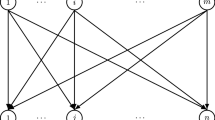Abstract
We use convex duality techniques to study a spatial Pareto problem with transport costs and derive a spatial second welfare theorem. The existence of an integrable equilibrium distribution of quantities is nontrivial and established under general monotonicity assumptions. Our variational approach also enables us to give a numerical algorithm à la Sinkhorn and present simulations for equilibrium prices and quantities in one-dimensional domains and a network of French cities.









Similar content being viewed by others
Notes
by nondecreasing we mean that \(\beta -\beta ' \in {\mathbb {R}}_+^N\) implies \(U(x, \beta ) \ge U(x, \beta ')\).
for simplicity, we take U independent of the location but there is no extra difficulty in having a dependence in y in a multiplicative prefactor or even in the exponents \(a_i\).
given by the website https://www.coordonnees-gps.fr/distance.
References
Villani, C.: Topics in optimal transportation. Graduate Studies in Mathematics, vol. 58. American Mathematical Society, Providence, RI (2003)
Santambrogio, F.: Optimal transport for applied mathematicians. Progress in Nonlinear Differential Equations and their Applications, 87. Birkhäuser/Springer, Cham (2015). Calculus of variations, PDEs, and modeling
Galichon, A.: Optimal Transport Methods in Economics. Princeton University Press, Princeton (2016)
Jordan, R., Kinderlehrer, David, Otto, F.: The variational formulation of the Fokker–Planck equation. SIAM J. Math. Anal. 29(1), 1–17 (1998)
Ambrosio, L., Gigli, N., Savaré, G.: Gradient Flows in Metric Spaces and in the Space of Probability Measures. Lectures in Mathematics ETH Zürich, 2nd edn. Birkhäuser, Basel (2008)
Marco, C.: Sinkhorn distances: Lightspeed computation of optimal transport. In Advances in Neural Information Processing Systems, pp 2292–2300 (2013)
Benamou, J. D., Carlier, G., Cuturi, M., Nenna, L., & Peyré, G.: Iterative Bregman projections for regularized transportation problems. SIAM J. Sci. Comput. 37(2), A1111–A1138 (2015)
Peyré, G., Cuturi, M.: Computational optimal transport: with applications to data science. Found. Trends Mach. Learn. 11(5–6), 355–607 (2019)
Peyré, G.: Entropic approximation of wasserstein gradient flows. SIAM J. Imaging Sci. 8(4), 2323–2351 (2015)
Komlós, J.: A generalization of a problem of Steinhaus. Acta Math. Acad. Sci. Hungar. 18, 217–229 (1967)
Rockafellar, R.T.: Integrals which are convex functionals. Pacific J. Math. 24, 525–539 (1968)
Rockafellar, R.T.: Integrals which are convex functionals. II. Pacific J. Math. 39, 439–469 (1971)
Ivar, E. and Roger, T.: Convex analysis and variational problems, volume 28 of Classics in Applied Mathematics. Society for Industrial and Applied Mathematics (SIAM), Philadelphia, english edition (1999)
Alfred, G., Bernard, S.: Cupid’s invisible hand: social surplus and identification in matching models. Rev. Econ. Stud. 89(5), 2600–2629 (2021)
Beck, A., Tetruashvili, L.: On the convergence of block coordinate descent type methods. SIAM J. Optim. 23(4), 2037–2060 (2013)
Acknowledgements
GC is grateful to the Agence Nationale de la Recherche for its support through the projects MAGA (ANR-16-CE40-0014) and MFG (ANR-16-CE40-0015-01). GC also acknowledges the support of the Lagrange Mathematics and Computation Research Center.
Funding
The authors have not disclosed any funding.
Author information
Authors and Affiliations
Corresponding author
Ethics declarations
Conflict of interest
The authors have not disclosed any competing interests..
Additional information
Publisher's Note
Springer Nature remains neutral with regard to jurisdictional claims in published maps and institutional affiliations.
Rights and permissions
Springer Nature or its licensor (e.g. a society or other partner) holds exclusive rights to this article under a publishing agreement with the author(s) or other rightsholder(s); author self-archiving of the accepted manuscript version of this article is solely governed by the terms of such publishing agreement and applicable law.
About this article
Cite this article
Bacon, X., Carlier, G. & Nazaret, B. A Spatial Pareto Exchange Economy Problem. Appl Math Optim 87, 45 (2023). https://doi.org/10.1007/s00245-022-09947-z
Accepted:
Published:
DOI: https://doi.org/10.1007/s00245-022-09947-z
Keywords
- Exchange economy Pareto optimality
- Optimal transport
- Convex duality
- Second welfare theorem
- Entropic optimal transport
- Sinkhorn algorithm




